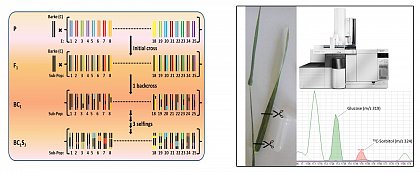Barley NAM Lines
Chris Richter, Dr. Manish Raorane
Through thousands of years of breeding, crop plants have been multiplied in their yield, but have lost a large proportion of their tolerance against herbivores, draught, and other biotic and abiotic stress factors. Furthermore, in recent years it has become evedent that a stagnation in yield has been reached. Thus, modern breeding approaches cross elite varieties with their wild ancestors, and then backcross to the elite lines. After several selfings, individuals of the resulting nested association mapping (NAM) line population each have a defined and homozygous part of the ancestral genome in the elite background. Through Genome Wide Association Studies (GWAS) it has been shown previously that the metabolic profile of seedlings can be used to predict the agronomical performance at the adult stage, which means that breeders can save valuable time and space. We are extending this approach to barley plants. Plant cultivation and population genomics is carried out by the group of Prof. Klaus Pillen (Institute of Agriculture & Nutrition), sampling is a joint effort, and metabolite profiling by GC- and LC-MS is carried out in our group.

